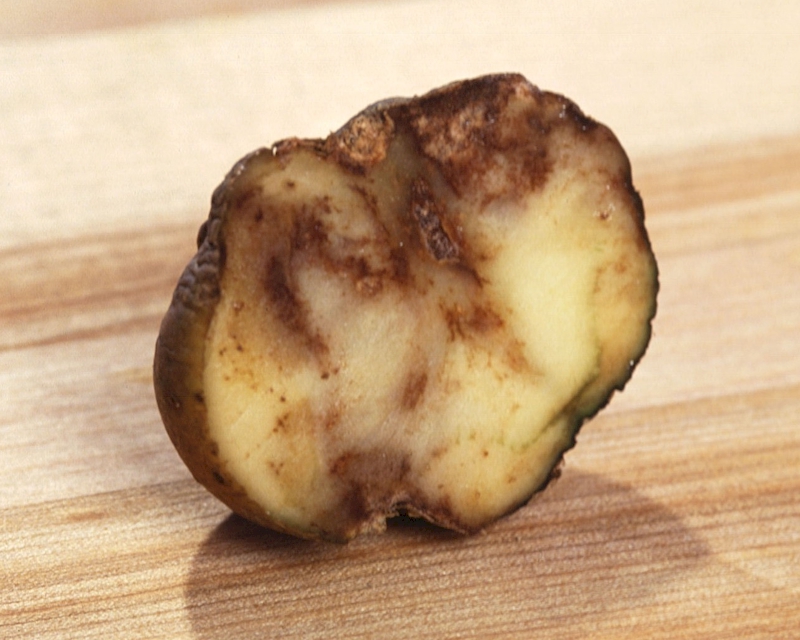Homepage → Gardening Related Topics → The Irish Potato Famine of the 1840s
The Irish Potato Famine of the 1840s
Planted July 27, 2001
Last tended to on October 10, 2024
Reading time: 4 minutes

by Catharina Japikse
More than a million Irish people – about one of every nine – died in the Great Potato Famine of the 1840s. To the Irish, famine of this magnitude was unprecedented and unimaginable. Today, it may seem less surprising, though no less tragic, as television delivers up images of starvation more vivid and more frequent than ever before.
Besides the horror, what unites the famines today with one over a century ago are the reasons behind them. Ireland’s famine and those of the 20th century have similar, complex causes: economic and political factors, environmental conditions, and questionable agricultural practices.
When the famine hit in 1845, the Irish had grown potatoes for over 200 years–since the South American plant had first arrived in Ireland. During this time, the lower classes had become increasingly dependent on them. Potatoes provided good nutrition, so diseases like scurvy and pellagra were uncommon. They were easy to grow, requiring a minimum of labor, training, and technology–a spade was the only tool needed. Storage was simple; the tubers were kept in pits in the ground and dug up as needed. Also, potatoes produce more calories per acre than any other crop that would grow in northern Europe. This was important to the Irish poor, who owned little, if any, of their own land. Often, a whole family could live for a year on just one acre’s worth.
To increase their harvest, farmers came to rely heavily on one variety, the lumper. While the lumper was among the worst tasting types, it was remarkably fertile, with a higher per-acre yield than other varieties. Economist Cormac Ó Gráda estimates that on the eve of the famine, the lumper and one other variety, the cup, accounted for most of the potato crop. For about 3 million people, potatoes were the only significant source of food, rarely supplemented by anything else.
It was this reliance on one crop–and especially one variety of one crop–that made the Irish vulnerable to famine. As we now know, genetic variation helps protect against the decimation of an entire crop by pests, disease, or climate conditions. Nothing shows this more poignantly than Ireland’s agricultural history.
At the beginning of the 19th century, a Dublin Society survey recorded at least a dozen varieties of potato cultivated in the county of Kilkenny alone. Then, adults could still remember when most of the poor raised oats, barley, or rye, along with beans and other green vegetables. But according to Ó Gráda, this diversity had largely disappeared by the 1840s. He notes that while some people warned that Ireland’s reliance on potatoes might prove disastrous, no one likely conceived of a famine as complete as what occurred. The poor certainly could not; it is doubtful they could have avoided it anyway, given the social and political conditions of their lives.
In 1845, the fungus Phytophthora infestans arrived accidentally from North America. A slight climate variation brought the warm, wet weather in which the blight thrived. Much of the potato crop rotted in the fields. Because potatoes could not be stored longer than 12 months, there was no surplus to fall back on. All those who relied on potatoes had to find something else to eat.
The blight did not destroy all of the crop; one way or another, most people made it through winter. The next spring, farmers planted those tubers that remained. The potatoes seemed sound, but some harbored dormant strains of the fungus. When it rained, the blight began again. Within weeks the entire crop failed.
Although the potatoes were ruined completely, plenty of food grew in Ireland that year. Most of it, however, was intended for export to England. There, it would be sold–at a price higher than most impoverished Irish could pay.
In fact, the Irish starved not for lack of food, but for lack of food they could afford. To buy food, many sold or pawned everything they owned. Often, this included the tools by which they made their living. Other people ate the food intended for rent, and the landlords quickly evicted them. By the next planting season, many farmers had no land to plant on, nor tools to plant with. Those who did often had nothing to plant. There were few potatoes, and no money with which to buy seed.
The Irish planted over two million acres of potatoes in 1845, according to Ó Gráda, but by 1847 potatoes accounted for only 300,000 acres. Many farmers who could turned to other crops. The potato slowly recovered, but the Irish, wary of dependence on one plant, never again planted it as heavily. The Irish had learned a hard lesson – one worth remembering.
Think it can’t happen again? Check out this article about the corn disease that swept the U.S. from south to north, threatened the complete loss of the 1971 harvest, and panicked the stock market. Click Here
Source: EPA Journal, Catharina Japikse, Assistant Editor, Fall 1994
Copyright © 1998 - 2024 - All rights reserved
WebGrower.com℠ is a service mark of Victory Horticultural Group, LLC.
• Privacy Statement •
This site participates in the Amazon Services LLC Associates Program, an affiliate advertising program designed to provide a means for sites to earn advertising fees by advertising and linking to amazon.com.